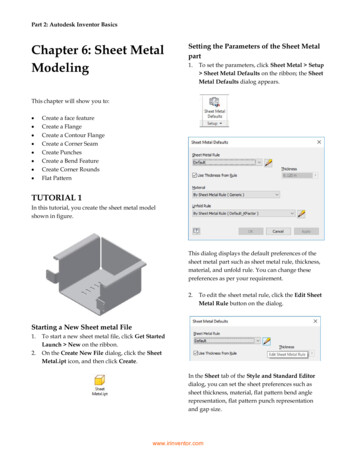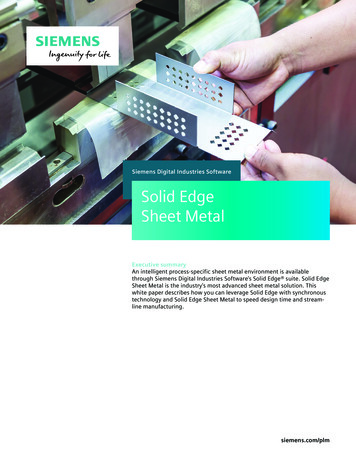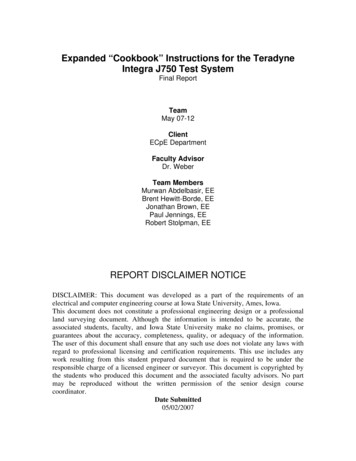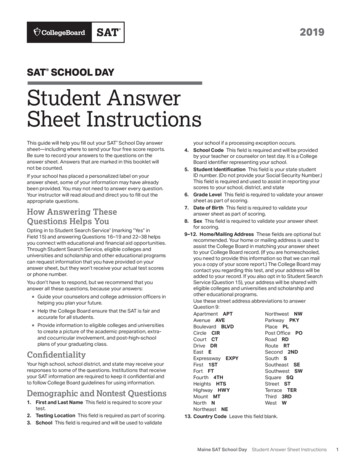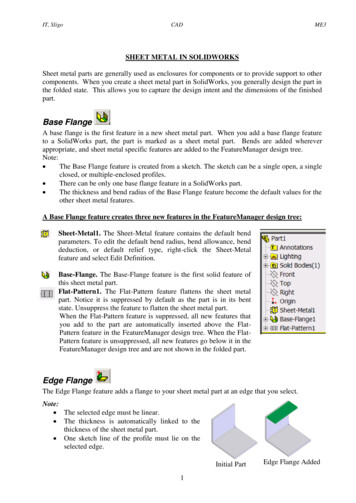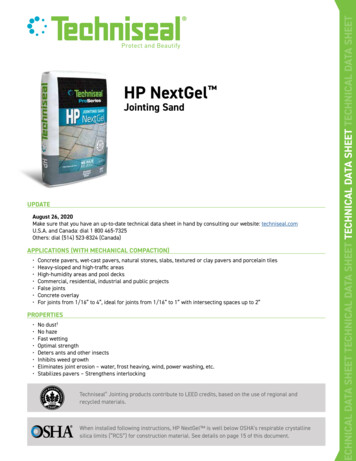
Transcription
Jointing SandUPDATEAugust 26, 2020Make sure that you have an up-to-date technical data sheet in hand by consulting our website: techniseal.comU.S.A. and Canada: dial 1 800 465-7325Others: dial (514) 523-8324 (Canada)APPLICATIONS (WITH MECHANICAL COMPACTION) Concrete pavers, wet-cast pavers, natural stones, slabs, textured or clay pavers and porcelain tilesHeavy-sloped and high-traffic areasHigh-humidity areas and pool decksCommercial, residential, industrial and public projectsFalse jointsConcrete overlayFor joints from 1/16” to 4”, ideal for joints from 1/16” to 1” with intersecting spaces up to 2”PROPERTIES No dust†No hazeFast wettingOptimal strengthDeters ants and other insectsInhibits weed growthEliminates joint erosion – water, frost heaving, wind, power washing, etc.Stabilizes pavers – Strengthens interlockingTechniseal Jointing products contribute to LEED credits, based on the use of regional andrecycled materials.When installed following instructions, HP NextGel is well below OSHA’s respirable crystallinesilica limits (“RCS”) for construction material. See details on page 15 of this document.ECHNICAL DATA SHEET TECHNICAL DATA SHEET TECHNICAL DATA SHEET TECHNICAL DATA SHEETHP NextGel
TECHNISEAL – TECHNICAL DATA SHEET –HP NextGel Jointing Sand2DESCRIPTIONTechniseal HP NextGel Jointing Sand is a state-of-the-art mix of graded sand and binder that flows smoothly down jointsfor a fast and effective installation of pavers or slabs with false, narrow or wide joints. It is also recommended for surfacesexposed to heavy traffic, for high-humidity areas and concrete overlay. Easy to use, HP NextGel Jointing sand starts toset only a few minutes after being activated with water, and quickly becomes resistant to water erosion (rain, splashes,sprinklers, etc.). HP NextGel Jointing sand is the go-to solution for all installations where mechanical compaction is done.It offers great resistance to weed growth, insect invasion, and erosion.Techniseal HP NextGel Jointing Sand is manufactured with a revolutionary technology. NextGel radically transforms andimproves the properties and behavior of jointing sand, resulting in the first ever true “no dust†”, “no haze” and “no waste”jointing sand for a fast, clean, durable and profitable installation.NextGel contains no dust from additives. The dust that can be found is of natural source and comes exclusively from the sand. This is especially true withgrey sand which is made from crushed sub-angular aggregates.†Minimum joint width: 1/16”Maximum joint width: 4”*Ideal joint width: from 1/16” to 1” with intersecting spaces up to 2”1/16” to 1”upto2”Minimum joint depth: 1.5”, except for porcelain tiles***For joint width wider than 1”, please refer to the natural stone sections under INSTALLATION QUICK-LINKS below.**For porcelain tile installation, please refer to dedicated section under INSTALLATION QUICK-LINKS below.DIRECTIONSALWAYS TEST ON A SMALL HIDDEN AREA OF APPROXIMATELY 4 SQ. FT. TO ENSURE THAT RESULT MEETS YOUREXPECTATIONS (SEE WARRANTY).BEFORE YOU BEGINIn order to ensure good cohesion and long-term resistance, jointing sand must imperatively dry completely before beingexposed to rain (24 to 48 hours minimum). The drying time will be extended in cold or humid weather and for wide jointsinstallations (wider than 1/2’’). Why? Like paint, jointing sand must dry completely to polymerize and offer all its advantages.However, jointing sand will be able to withstand unexpected rain 60 minutes after installation.INSTALLATION CONDITIONS Temperature must be above 32 F for 48 hours following installation. Surface and joints must be dry. Sprinkler system must be turned off.TRAFFICPedestrian: Immediate / Vehicular: 48 to 72 h. Block access during that period.COMPACTION INFORMATIONMechanical compaction is MANDATORY when using HP NextGel Jointing Sand. Failure to do so may compromise jointintegrity and performance. If joint width is greater than ¼” and mechanical compaction is either not possible or traditionallynot used, please use Techniseal’s NOCO polymeric joint.
TECHNISEAL – TECHNICAL DATA SHEET –HP NextGel Jointing Sand3CAUTION Wear appropriate safety gear. Do not mix product with cement, sand or any other material. Ensure that joint has hardened before cleaning and sealing the surface. Depending on climate and type of installation,typical recommended wait time is a minimum of 7 days after installation and may take up to 30 days. Not for use on submerged or constantly wet surfaces. Joints become soft when humid but become hard again when dry. Because product comes from a natural source, color and grain size may vary. This product starts repelling water a few minutes after initial wetting. Make sure to complete each section per detailedinstallation instructions before moving to the next one. The use of cleaning devices (high pressure washer, etc.) is restricted during the first 30 days. It should be noted that toodirect and violent jets can create alterations, so it is best to consult the machine manufacturers in order to use the specificaccessories with soft jets. Failure to have recessed joint could lead to premature joint degradation. Do not sweep product over asphalt. Bedding layer needs to be able to drain properly in order to allow for the HP NextGel Jointing Sand to dry properly.Certain type of bedding or screening materials may not drain properly which will trap moisture and may cause issues. Proper maintenance is paramount to maintaining joints in optimal condition. Excessive moisture, shade, inadequatecleaning and maintenance, presence of soil and organic matters (including grass trimmings) left on the joints maycontribute to growth of moss, mold or mildew.IMPORTANT: Do not use this product as capping sand.INSTALLATION QUICK-LINKSInstallation on a Draining Base with Pavers (see page 3)Installation on a Draining Base with Natural Stone and Slabs (see page 5)Installation on a Draining Base with Porcelain Tiles (see page 7)Installation on Concrete Overlay with Pavers, Natural Stone and Slabs (see page 9)Installation on Concrete Overlay with Porcelain Tiles (see page 11)INSTALLATION ON A DRAINING BASE WITH PAVERS (INCLUDING FALSE JOINTS)(JOINT WIDTH FROM 1/16’’ TO 1/2”)The hardscape products should be installed following the manufacturer’s recommendation. For pavers, ICPI TechnicalSpecification Spec #2 (www.icpi.org) should be used.NECESSARY TOOLS Street broom with semi-rigid bristles. Plate compactor or Paver roller.Plate compactor such as Multiquip’s Mikasa MVB series, Wacker Neuson’s VP and WP series, Toro’s FP series areexamples of models that can be used to ensure proper mechanical compaction. Use of a teflon coated plate or pavingpad is important to help protect the surface.Plate compactor – Ideally, the plate compactor should have a minimum centrifugal force of 25 kN (5,000 lbf) and afrequency between 80 and 100 Hz. The weight of the plate compactor should not exceed 100 kg (220 lb). A smallermachine can be used for repair work and joint replacement.Paver roller such as Weber MT’s VPR 450 & VPR 700, EZG’s EVPC120, ESI’s EVPC120H are examples of models thatcan be used to ensure proper mechanical compaction. Use of rubber-coated or nylon rollers is important to helpprotect the surface. Hand tamper may be needed in restricted areas where using heavier equipment may not be possible. Leaf blower. Spray nozzle and garden hose.
TECHNISEAL – TECHNICAL DATA SHEET –HP NextGel Jointing Sand4INSTALLATION - IMPORTANT1Spread product evenly on a smallsurface.2 sing the street broom, fill jointsUcompletely. Spread sand over shortdistances.3Pass the plate compactor or paverroller over the entire surface tocompact the sand.4 pread more product to fill jointsSagain.6Remove excess sand from thesurface with the broom.8Sand level must be at least 1/8”below top of pavers or up to thebottom of the chamfer.10I mmediately afterwards, wet thesame section for 30 seconds.Mechanical compaction should ideally bedone starting from center of installation,working towards the edges. Please followbest practices for mechanical compactionas outlined by ICPI.5Pass the plate compactor or paverroller over the entire surface asecond time.For thicker hardscape products, additionalmechanical compaction may be requireduntil joint saturation is reached.Proper compaction does not allow a fingerto sink into the joint.9Starting from bottom of the slope,quickly shower a 200 sq. ft. section**to set the sand (10 to 15 seconds).10 - 15 sec.Activation instructions are valid for jointwidths from 1/16” to 1/2”.rShowe evel the height of the sand withLthe leaf blower.rShowe730 sec.Check for water accumulation at the surface of the jointing sand as a cue to stop watering. Wait until there is no freewater at the surface of the joint and verify the depth of activation. If HP NextGel is activated at 75% or more of its depthstop watering. If activated at less than 75%, water for an additional 15 seconds and check again after 30 seconds. Avoidoverwatering HP NextGel as this will significantly lengthen the curing time and may compromise product performance.11On textured pavers, use the blowerto remove the excess water off thesurface and into the joints.END OF SUB-SECTION FOR INSTALLATION ON DRAINING BASE WITH PAVERS
TECHNISEAL – TECHNICAL DATA SHEET –HP NextGel Jointing Sand5INSTALLATION ON A DRAINING BASE WITH NATURAL STONE (INCLUDING FLAGSTONE)AND SLABS (JOINT WIDTH FROM 1/16” TO 4”)The hardscape products should be installed following the manufacturer’s recommendation. Prior to applying HP NextGel ,make sure that the natural stones or slabs are well embedded in the bedding layer. For flagstone, the Natural StoneInstitute guideline should be followed (www.naturalstoneinstitute.org). For slabs, ICPI Technical Specification Spec #2(www.icpi.org) should be used.For installation with natural stones, wait two days after installation of the trial area to confirm that there is no staining ofthe natural stones caused by the migration of some of the ingredients of the polymeric sand mix into the stones (such asa halo effect / picture frame on the outline of the stones, a phenomenon known with all jointing systems such as mortars,epoxy joints, and others).COMPACTION INFORMATIONFollow the manufacturer’s recommendation for mechanical compaction.For natural stone, use a paver roller. If joint width is greater than ¼” and mechanical compaction is either not possible ortraditionally not used, please use Techniseal’s NOCO polymeric joint.CAUTION SPECIFIC TO NATURAL STONE AND SLABSIf using a plate compactor over natural stone, add a membrane such as a flat-joint plastic snow fence or a 5/8” thickplywood sheet.For slabs with a sensitive surface, use a plate compactor with a membrane such as a flat-joint plastic snow fence placedon top of the paved surface. For slabs of larger dimensions, it may be possible to use a plate compactor while protectingthe slabs by 5/8” thick plywood sheets. This method should however be used with caution to avoid possible damage to theslabs.NECESSARY TOOLS Street broom with semi-rigid bristles. Plate compactor or Paver roller (slab) / Paver roller (natural stone).Plate compactor such as Multiquip’s Mikasa MVB series, Wacker Neuson’s VP and WP series, Toro’s FP series areexamples of models that can be used to ensure proper mechanical compaction. Use of a teflon coated plate or pavingpad is important to help protect the surface.Plate compactor – Ideally, the plate compactor should have a minimum centrifugal force of 25 kN (5,000 lbf) and afrequency between 80 and 100 Hz. The weight of the plate compactor should not exceed 100 kg (220 lb). A smallermachine can be used for repair work and joint replacement.Paver roller such as Weber MT’s VPR 450 & VPR 700, EZG’s EVPC120, ESI’s EVPC120H are examples of models that canbe used to ensure proper mechanical compaction. Use of rubber-coated or nylon rollers is important to help protect thesurface. Hand tamper may be needed in restricted areas where using heavier equipment may not be possible. Leaf blower. Spray nozzle and garden hose.
TECHNISEAL – TECHNICAL DATA SHEET –HP NextGel Jointing Sand6INSTALLATION - IMPORTANT1 pread product evenly on a smallSsurface.2Using the street broom, fill jointscompletely. Spread sand over shortdistances.3Pass the paver roller over theentire surface to compact the sand.4Spread more product to fill jointsagain.6 emove excess sand from theRsurface with the broom.8Sand level must be at least 1/8”below top of natural stone or slabs.Mechanical compaction should ideally bedone starting from center of installation,working towards the edges. Please followbest practices for mechanical compaction asoutlined by ICPI or Natural Stone Instituteguidelines.5Pass the paver roller over theentire surface a second time.For wider joints and/or thicker hardscapeproducts, additional mechanical compactionmay be required until joint saturation isreached. Proper compaction does not allowa finger to sink into the joint.7Level the height of the sand withthe leaf blower.9rShoweHP NEXTGEL ACTIVATION INSTRUCTION FOR TYPICAL INSTALLATION ON DRAINING BASEWITH NATURAL STONE AND SLABSFor natural stone with joints up to 2’’, intersecting spaces up to 4’’ and stone thickness up to2’’: with your sprayer set at shower, starting at the bottom of the slope, water each section of50 sq. ft. for 15 seconds to set sand. Immediately afterwards, wet the same section up to45 seconds. Check for water accumulation at the surface of the jointing product as a cue to stopwatering. Wait until there is no free water at the surface of the joint and verify the depth of activation. If HP NextGel isactivated at 75% or more of its depth stop watering. If activated at less than 75%, water for an additional 15 seconds andcheck again after 30 seconds. Avoid overwatering HP NextGel as this will significantly lengthen the curing time and maycompromise product performance.For large slabs* with joint width from 1/16” to ¼’’: with your sprayer set at shower, starting at the bottom of the slope,water each section of 200 sq. ft. for 10-15 seconds to set sand. Immediately afterwards, wet the same section up to 15-20seconds. Check for water accumulation at the surface of the jointing product as a cue to stop watering. Wait until there is nofree water at the surface of the joint and verify the depth of activation. If HP NextGel is activated at 75% or more of its depthstop watering. If activated at less than 75%, water for an additional 10 seconds and check again after 30 seconds. Avoidoverwatering HP NextGel as this will significantly lengthen the curing time and may compromise product performance.*It is very easy to overwater installations with large slabs. Carefully track the watering time during the activation process.
TECHNISEAL – TECHNICAL DATA SHEET –HP NextGel Jointing Sand107Optional - on porous naturalstone, use the blower to removethe excess water off the surfaceand into the joints.END OF SUB-SECTION FOR INSTALLATION ON DRAINING BASE WITH NATURAL STONE AND SLABSINSTALLATION ON A DRAINING BASE WITH PORCELAIN TILES (JOINT WIDTH FROM 1/16” TO 3/8”)The hardscape products should be installed following the manufacturer’s recommendation. Prior to applying HP NextGel ,make sure that the natural stones or slabs are well embedded in the bedding layer. For flagstone, the Natural StoneInstitute guideline should be followed (www.naturalstoneinstitute.org). For slabs, ICPI Technical Specification Spec #2(www.icpi.org) should be used.COMPACTION INFORMATIONFollow the manufacturer’s recommendation for mechanical compaction.For porcelain tiles, use a paver roller. Do not use a plate compactor. If joint width is greater than ¼” and mechanicalcompaction is either not possible or traditionally not used, please use Techniseal’s NOCO polymeric joint.CAUTION SPECIFIC TO PORCELAIN TILESMechanical compaction should be done until joint is saturated. Several passes may be required.Always pre-compact and strike off your sand leveling course before installing your porcelain pavers in sand set installations.Water must be able to drain through the native soils or any other appropriate aggregate located underneath the installation.In areas where water is unable to evacuate, excessive moisture and humidity will buildup which will negatively impact theperformance of the polymeric sand.NECESSARY TOOLS Street broom with semi-rigid bristles. Paver roller such as Weber MT’s VPR 450 & VPR 700, EZG’s EVPC120, ESI’s EVPC120H are examples of models that canbe used to ensure proper mechanical compaction. Use of rubber-coated or nylon rollers is important to help protect thesurface. Hand tamper may be needed in restricted areas where using heavier equipment may not be possible. Leaf blower. Spray nozzle and garden hose.
TECHNISEAL – TECHNICAL DATA SHEET –HP NextGel Jointing Sand8INSTALLATION - IMPORTANT2Using the street broom, fill jointscompletely. Spread sand over shortdistances.3Pass the paver roller over theentire surface to compact the sand.4Spread more product to fill jointsagain.5 ass the paver roller over thePentire surface a second time.Multiple passes may be requireduntil joint saturation is reached.6 emove excess sand from theRsurface with the broom.7Level the height of the sand withthe leaf blower.8Sand level must be at least 1/8”below top of tiles.9Starting from bottom of the slope,quickly shower a 100 sq. ft. section**to set the sand (10 to 15 seconds).10I mmediately afterwards, wet thesame section for 10-15 seconds.10 - 15 sec.rShoweSpread product evenly on a smallsurface.rShowe110 - 15 sec.Check for water accumulation at the surface of the jointing sand as a cue to stop watering. Wait until there is no freewater at the surface of the joint and verify the depth of activation. If HP NextGel is activated at 75% or more of its depthstop watering. If activated at less than 75%, water for an additional 10 seconds and check again after 30 seconds. Avoidoverwatering HP NextGel as this will significantly lengthen the curing time and may compromise product performance.*It is very easy to overwater installations with large tiles. Carefully track the watering time during the activation process.END OF SUB-SECTION FOR INSTALLATION ON DRAINING BASE WITH PORCELAIN TILES
TECHNISEAL – TECHNICAL DATA SHEET –HP NextGel Jointing Sand9INSTALLATION ON CONCRETE OVERLAY WITH PAVERS (INCLUDING FALSE JOINTS), NATURAL STONE(INCLUDING FLAGSTONE) AND SLABS (JOINT WIDTH FROM 1/16” TO 4”)The hardscape products should be installed following the manufacturer’s recommendation. Prior to applying HP NextGel ,make sure that the pavers, stones or slabs are well embedded in the bedding layer. For flagstone, the Natural StoneInstitute guideline should be followed (www.naturalstoneinstitute.org). For pavers and slabs, ICPI Technical SpecificationSpec #10 and #20 (www.icpi.org) should be used for drainage, position and slope requirements.For installation with natural stones, wait two days after installation of the trial area to confirm that there is no staining ofthe natural stones caused by the migration of some of the ingredients of the polymeric sand mix into the stones (such asa halo effect / picture frame on the outline of the stones, a phenomenon known with all jointing systems such as mortars,epoxy joints, and others).COMPACTION INFORMATIONFollow the manufacturer’s recommendation for mechanical compaction.For natural stone, use a paver roller. If joint width is greater than ¼” and mechanical compaction is either not possible ortraditionally not used, please use Techniseal’s NOCO polymeric joint.CAUTION SPECIFIC TO NATURAL STONE AND SLABSFor slabs with a sensitive surface, use a plate compactor with a membrane such as a flat-joint plastic snow fence placed ontop of the paved surface.NECESSARY TOOLS Street broom with semi-rigid bristles. Paver roller such as Weber MT’s VPR 450 & VPR 700, EZG’s EVPC120, ESI’s EVPC120H are examples of models that canbe used to ensure proper mechanical compaction. Use of rubber coated rollers is important to help protect the surface. Hand tamper may be needed in restricted areas where using heavier equipment may not be possible. Leaf blower. Spray nozzle and garden hose.
TECHNISEAL – TECHNICAL DATA SHEET –HP NextGel Jointing Sand10INSTALLATION - IMPORTANT1Spread product evenly on a smallsurface.2Using the street broom, fill jointscompletely. Spread sand over shortdistances.3Pass the paver roller over theentire surface to compact the sand.4Spread more product to fill jointsagain.6Remove excess sand from thesurface with the broom.8Sand level must be at least 1/8”below top of pavers, natural stoneor slabs or up to the bottom of thechamfer.Mechanical compaction should ideally bedone starting from center of installation,working towards the edges. Please followbest practices for mechanical compaction asoutlined by ICPI or Natural Stone Instituteguidelines.5 ass the paver roller over thePentire surface a second time.For wider joints and/or thicker hardscapeproducts, additional mechanical compactionmay be required until joint saturation isreached. Proper compaction does not allowa finger to sink into the joint.7Level the height of the sand withthe leaf blower.9rShoweHP NEXTGEL ACTIVATION INSTRUCTION FOR TYPICAL INSTALLATION ON CONCRETE ORCEMENT-SAND BASE WITH PAVERS, NATURAL STONE AND SLABSFor pavers with joints from 1/16” to 1/2”: with your sprayer set at shower, starting at the bottom of theslope, water each section of 200 sq. ft. for 10-15 seconds to set the sand. Immediately afterwards, wet thesame section for 20 seconds. Check for water accumulation at the surface of the jointing product as a cue tostop watering. Wait until there is no free water at the surface of the joint and verify the depth of activation. IfHP NextGel is activated at 75% or more of its depth stop watering. If activated at less than 75%, water foran additional 15 seconds and check again after 30 seconds. Avoid overwatering HP NextGel as this will significantly lengthen thecuring time and may compromise product performance.For natural stone with joints up to 2’’, intersecting spaces up to 4’’ and stone thickness up to 2’’: with your sprayer set at shower,starting at the bottom of the slope, water each section of 50 sq. ft. for 15 seconds to set the sand. Immediately afterwards, wet thesame section up to 30 seconds. Check for water accumulation at the surface of the jointing product as a cue to stop watering. Waituntil there is no free water at the surface of the joint and verify the depth of activation. If HP NextGel is activated at 75% or moreof its depth stop watering. If activated at less than 75%, water for an additional 15 seconds and check again after 30 seconds. Avoidoverwatering HP NextGel as this will significantly lengthen the curing time and may compromise product performance.For large slabs* with joint width from 1/16” to ¼’’: with your sprayer set at shower, starting at the bottom of the slope, water eachsection of 200 sq. ft. for 10-15 seconds to set the sand. Immediately afterwards, wet the same section up to 10-15 seconds. Check forwater accumulation at the surface of the jointing product as a cue to stop watering. Wait until there is no free water at the surface ofthe joint and verify the depth of activation. If NextGel is activated at 75% or more of its depth stop watering. If activated at less than75%, water for an additional 10 seconds and check again after 30 seconds. Avoid overwatering HP NextGel as this will significantlylengthen the curing time and may compromise product performance.*It is very easy to overwater installations with large slabs. Carefully track the watering time during the activation process.
TECHNISEAL – TECHNICAL DATA SHEET –HP NextGel Jointing Sand1011Optional - on textured pavers orporous natural stone, use theblower to remove the excesswater off the surface and into thejoints.END OF SUB-SECTIONFOR INSTALLATION ON CONCRETE OVERLAY WITH PAVERS, NATURAL STONE AND SLABSINSTALLATION ON CONCRETE OVERLAY WITH PORCELAIN TILES (JOINT WIDTH FROM 1/16” TO 3/8”)COMPACTION INFORMATIONFollow the manufacturer’s recommendation for mechanical compaction.For porcelain tiles, use a paver roller. Do not use a plate compactor. If joint width is greater than ¼” and mechanicalcompaction is either not possible or traditionally not used, please use Techniseal’s NOCO polymeric joint.CAUTION SPECIFIC TO PORCELAIN TILESMechanical compaction should be done until joint is saturated. Several passes may be required.Never install porcelain pavers without the required spacing between them. The porcelain pavers should never be installedwith a porcelain to porcelain contact.Water must be able to drain through the concrete material located underneath the installation. In areas where water isunable to evacuate, excessive moisture and humidity will buildup which will negatively impact the performance of thepolymeric sand.NECESSARY TOOLS Street broom with semi-rigid bristles. Paver roller such as Weber MT’s VPR 450 & VPR 700, EZG’s EVPC120, ESI’s EVPC120H are examples of models thatcan be used to ensure proper mechanical compaction. Use of rubber-coated or nylon rollers is important to helpprotect the surface. Hand tamper may be needed in restricted areas where using heavier equipment may not be possible. Leaf blower. Spray nozzle and garden hose.
TECHNISEAL – TECHNICAL DATA SHEET –HP NextGel Jointing Sand12INSTALLATION - IMPORTANT2Using the street broom, fill jointscompletely. Spread sand over shortdistances.3 Passthe paver roller over theentire surface to compact the sand.4 pread more product to fill jointsSagain.5Pass the paver roller over theentire surface a second time.Multiple passes may be requireduntil joint saturation is reached.6Remove excess sand from thesurface with the broom.7 evel the height of the sand withLthe leaf blower.8Sand level must be at least 1/8”below top of tiles.9 tarting from bottom of the slope,Squickly shower a 100 sq. ft. section**to set the sand (10 to 15 seconds).10I mmediately afterwards, wet thesame section for 10 seconds.10 - 15 sec.rShoweSpread product evenly on a smallsurface.rShowe110 sec.Check for water accumulation at the surface of the jointing sand as a cue to stop watering. Wait until there is no freewater at the surface of the joint and verify the depth of activation. If HP NextGel is activated at 75% or more of its depthstop watering. If activated at less than 75%, water for an additional 5 seconds and check again after 30 seconds. Avoidoverwatering HP NextGel as this will significantly lengthen the curing time and may compromise product performance.*It is very easy to overwater installations with large tiles. Carefully track the watering time during the activation process.END OF SUB-SECTION FOR INSTALLATION ON CONCRETE OVERLAY WITH PORCELAIN TILES
TECHNISEAL – TECHNICAL DATA SHEET –HP NextGel Jointing Sand13COVERAGEFor a 50 lb bag:Narrow joints: 60 to 120 sq. ft.Wide joints: 25 to 40 sq. ft. For a more precise evaluation of the coverage, please refer to the product calculator attechniseal.com.The amount required will depend on the shape and size of the slabs, tiles and pavers, as well as the width and depth of the joints.STORAGE AND SHELF LIFEUnused bags can be stored outside if they are still on a pallet and protected by the original packaging.PACKAGINGJointing ProductHPNextGel Product codeColorRetail Size40100596 (291-H37)Tan50 lb (bag)5640100597 (291-H47)Granite50 lb (bag)5640100598 (291-H77)Urban Grey50 lb (bag)5640105612Grey50 lb (bag)5640108003 (291-H87)Black50 lb (bag)5640105613 (291-H97)Ivory50 lb (bag)5640100600 (2W1-H47)Pacific Grey50 lb (bag)5640100251 (ID21-H37)Western Tan50 lb (bag)5640100590 (ID21-H47)Western Grey50 lb (bag)5640105501 (MI21-H37)Mojave Tan50 lb (bag)5640100592 (MP21-H27)Bourbon Tan50 lb (bag)5640101146 (MP21-H37)Southern Tan50 lb (bag)5640101147 (MP21-H47)Southern Grey50 lb (bag)5640100397 (NE21-H37)Prairie Tan50 lb (bag)5640100396 (NE21-H47)Prairie Grey50 lb (bag)5640105142Summit Grey50 lb (bag)56Color varies from one region to another. Shipping fees will be added to non-local sands.Consult your Techniseal dealer for color availability, pricing and delivery time.Units per pallet
TECHNISEAL – TECHNICAL DATA SHEET –HP NextGel Jointing Sand14SAFETY WARNINGSMAY IRRITATE EYES. MAY IRRITATE SKIN. CAUSES RESPIRATORY TRACT, DIGESTIVE TRACT AND EYE BURNS. CAUSESSKIN BURNS. MAY CAUSE ALLERGIC SKIN REACTION. Do not swallow. Do not get on skin or clothing. Do not get in eyes.Do not breathe dust.For information and advice regarding transportation, handling, storage, first aid and disposal of chemicals products, usersshould refer to the Safety Data Sheet containing physical, ecological, toxicological and other safety-related data.KEEP OUT OF REACH OF CHILDREN. Keep container tightly closed and sealed until ready for use. Wash thoroughly afterhandling.FIRST AID TREATMENT: Contains: Hydraulic Cement. If swallowed, call a Poison Control Centre or doctor immediately.Get medical attention if symptoms occur. DO NOT induce vomiting. If in eyes or on skin, rinse well with water. If breathedin, move person to fresh air.EMERGENCY PHONE: CANUTEC (613) 996-6666. SEE SAFETY DATA SHEET FOR THIS PRODUCTSHIPPINGLand and seaNOT REGULATEDTECHNICAL INFORMATIONPropertiesTest methodSpecificationParticle Size DistributionASTM C-136100% passing No 8 sieve (2.38 mm) 5% passing No 200 sieve (0.074 mm)Exceeds ASTM C144Mohs Hardness Scale 5 for grey 6 for tan/beigeCompression StrengthASTM C-109** 1000 psi (7 MPa)Water Absorption (15 minutes)ASTM C-642* 10%*Results depend on sourcing of sand. For information on a specific sand, please contact the Technical Service Department**Sample preparation adapted for water activated product.
TECHNISEAL – TECHNICAL
Installation on Concrete Overlay with Pavers, Natural Stone and Slabs (see page 9) Installation on Concrete Overlay with Porcelain Tiles (see page 11) INSTALLATION ON A DRAINING BASE WITH PAVERS (INCLUDING FALSE JOINTS) (JOINT WIDTH FROM 1/16'' TO 1/2") The hardscape products should be installed following the manufacturer's recommendation.
